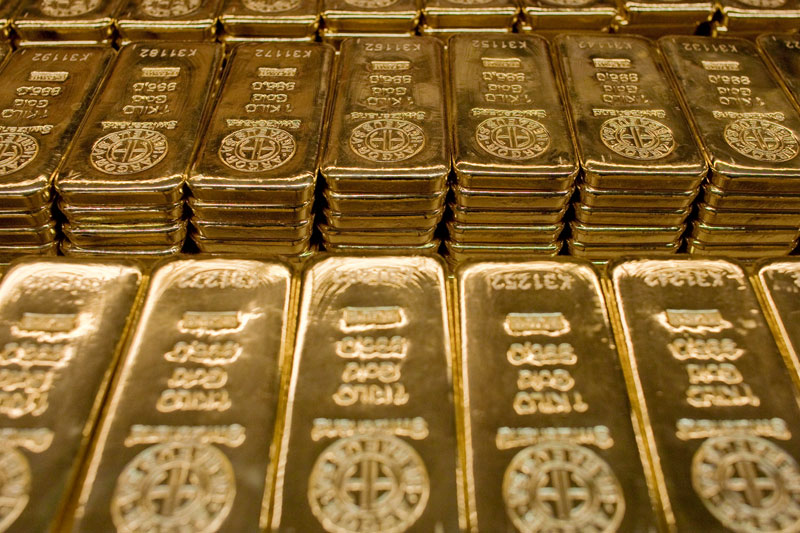Investing.com - Gold prices rose in Asia on Monday as investors noted manufacturing data out of China at the weekend and looked ahead to a private estimate tomorrow.
Gold for June delivery on the Comex division of the New York Mercantile Exchange rose 0.45% to $1,296.25 a troy ounce.
Silver futures for May delivery rose 0.12% to $17.810 a troy ounce, while copper futures dropped 0.18% to $2.274 a pound.
On Tuesday, comes the closely-watched Caixin manufacturing PMI for April, which last came in at 49.7. Markets in China are shut on Monday for a holiday.
At the weekend, the China April CFLP manuacturing index came in at 50.1, below expectations, but hanging onto expansion territory. The CFLP service PMI eased to 53.5 from 53.8. The semi-official manufacturing PMI from the China Federation of Logistics and Purchasing and National Bureau of Statistics slid from the first over-50 reading in eight months in March.
On the positive side, this is still the second consecutive over-50 reading - the first time that's happened since the middle of last year. Although gauges of output, new orders and export orders slipped marginally, they are still around the average of the past year.
The CFLP tried to downplay the slide in the manufacturing PMI, saying in an accompanying statement that "the stabilizing and recovering trend of the economy remains intact. The modest drop in the index is a normal fluctuation."
The U.S. Institute of Supply Management is to publish a report on manufacturing activity. The U.S. and China are the world’s two largest oil consuming nations and manufacturing numbers are used as indicators for fuel demand growth.
Also on the Comex, copper for July delivery spiked 5.2 cents, or 2.33%, on Friday to end at $2.283 a pound. For the week, New York-traded copper prices inched up 1.4 cents, or 0.44%.
The semi-official China's manufacturing purchasing managers' index published Sunday dipped to 50.1 last month from 50.2 in March, compared to expectations for a reading of 50.4.
The Asian nation is the world’s largest copper consumer, accounting for nearly 45% of world consumption.
In the week ahead, European Central Bank President Mario Draghi is due to deliver a speech titled "The future of financial markets: A changing view of Asia" at the Asian Development Bank annual meeting, in Frankfurt.
Later in the day, the U.S. Institute of Supply Management is to publish a report on manufacturing activity, while San Francisco Fed President John Williams will speak at a public event.
Innvestors will also focus on Friday’s U.S. nonfarm payrolls report for April to gauge if the world's largest economy is strong enough to withstand further rate hikes in 2016.
There is also ISM manufacturing data on Monday and ISM services on Wednesday. In addition, there are more than a half-dozen Fed speakers on tap for the coming week as traders search for more clues on the timing of the next U.S. rate hike.
Last week, gold prices soared to a 15-month peak on Friday, as a broadly weaker U.S. dollar and indications that the Federal Reserve was in no hurry to raise interest rates boosted the yellow metal.
The dollar dropped to an 18-month low of 106.28 against the yen on Friday, with the pair posting its biggest weekly percentage decline since the 2008 financial crisis in the aftermath of the Bank of Japan's decision not to ease policy further.
Dollar weakness usually benefits gold, as it boosts the metal's appeal as an alternative asset and makes dollar-priced commodities cheaper for holders of other currencies.
The U.S. central bank left interest rates unchanged following its two-day meeting on Wednesday and issued a statement implying it was in no hurry to raise rates.
Offering little hope of a move in June, the Fed said U.S. "economic conditions will evolve in a manner that will warrant only gradual increases in the federal funds rate."
Data released Thursday revealed that the U.S. economy grew at an annualized rate of just 0.5% in the first quarter, its weakest pace in two years, while a report on Friday showed that U.S. inflation barely rose in March as consumer spending remained tepid.
The downbeat data makes it less likely that the Fed will be able to follow through on its projected two interest rate increases this year.
A gradual path to higher rates is seen as less of a threat to gold prices than a swift series of increases.
Prices of the yellow metal are up nearly 22% so far this year as expectations faded that the Fed would move to normalize interest rates due to fears over the global economy.
Gold is sensitive to moves in U.S. rates, as a rise would lift the opportunity cost of holding non-yielding assets such as bullion.
